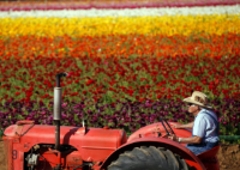The Precision Agriculture Revolution: Making the Modern Farmer
The Precision Agriculture Revolution: Making the Modern Farmer
April 29, 2015
"Thousands of years ago, agriculture began as a highly site-specific activity. The first farmers were gardeners who nurtured individual plants, and they sought out the microclimates and patches of soil that favored those plants. But as farmers acquired scientific knowledge and mechanical expertise, they enlarged their plots, using standardized approaches—plowing the soil, spreading animal manure as fertilizer, rotating the crops from year to year—to boost crop yields. Over the years, they developed better methods of preparing the soil and protecting plants from insects and, eventually, machines to reduce the labor required. Starting in the nineteenth century, scientists invented chemical pesticides and used newly discovered genetic principles to select for more productive plants. Even though these methods maximized overall productivity, they led some areas within fields to underperform. Nonetheless, yields rose to once-unimaginable levels: for some crops, they increased tenfold from the nineteenth century to the present.
Today, however, the trend toward ever more uniform practices is starting to reverse, thanks to what is known as “precision agriculture.” Taking advantage of information technology, farmers can now collect precise data about their fields and use that knowledge to customize how they cultivate each square foot.
One effect is on yields: precision agriculture allows farmers to extract as much value as possible from every seed. That should help feed a global population that the UN projects will reach 9.6 billion by 2050. Precision agriculture also holds the promise of minimizing the environmental impact of farming, since it reduces waste and uses less energy. And its effects extend well beyond the production of annual crops such as wheat and corn, with the potential to revolutionize the way humans monitor and manage vineyards, orchards, livestock, and forests. Someday, it could even allow farmers to depend on robots to evaluate, fertilize, and water each individual plant—thus eliminating the drudgery that has characterized agriculture since its invention.
ACRE BY ACRE
The U.S. government laid the original foundations for precision agriculture in 1983, when it announced the opening up of the Global Positioning System (GPS), a satellite-based navigation program developed by the U.S. military, for civilian use. Soon after, companies began developing what is known as “variable rate technology,” which allows farmers to apply fertilizers at different rates throughout a field. After measuring and mapping such characteristics as acidity level and phosphorous and potassium content, farmers match the quantity of fertilizer to the need. For the most part, even today, fields are tested manually, with individual farmers or employees collecting samples at predetermined points, packing the samples into bags, and sending them to a lab for analysis. Then, an agronomist creates a corresponding map of recommended fertilizers for each area designed to optimize production. After that, a GPS-linked fertilizer spreader applies the selected amount of nutrients in each location."
Read more from Foreign Affairs.
